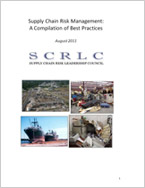 Supply Chain Risk Leadership Council (SCRLC)
Supply Chain Risk Leadership Council (SCRLC)
Sinopse: Modern enterprises increasingly find themselves relying on others for their success. Historically, enterprises have spent less than a third of their budgets on purchased goods and services, having relied on internal sources for these. Today, many enterprises spend most of their budget on purchased goods and services. This is in large part because of the advantages enterprises have found in strategies such as globalization, outsourcing, supply-base rationalization, just-in time deliveries, and lean inventories. In addition, many companies have consolidated operations both internally and externally to achieve economies of scale.
While globalization, extended supply chains, and supplier consolidation offer many benefits in efficiency and effectiveness, they can also make supply chains more brittle and can increase risks of supply-chain disruption. Historic and recent events have proven the need to identify and mitigate such risks. The March 2011 Tohoku earthquake andsubsequent tsunami in Japan showed how one event can disrupt many elements of global supply chains, including supply, distribution, and communications (Lee and Pierson, 2011). In extreme cases, a single event at one location can severely damage an enterprise or even cause it to leave an industry.
Effective supply-chain risk management (SCRM) is essential to a successful business. It is also a competence and capability many enterprises have yet to develop. In some areas, both problems and practices are well defined. In others, problems are defined, but practices are developing. In still other areas, both the definition of the problems and the practices needed to address them are developing. In sum, SCRM is an evolving field.
